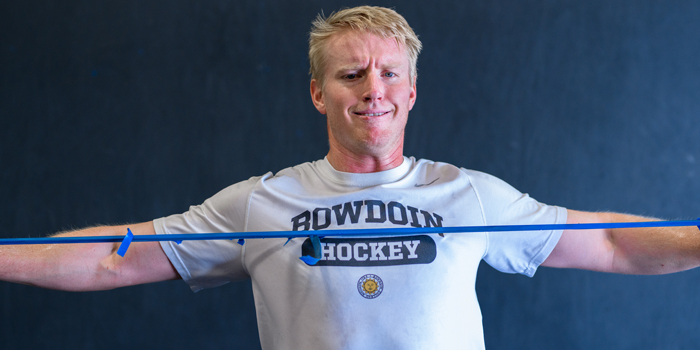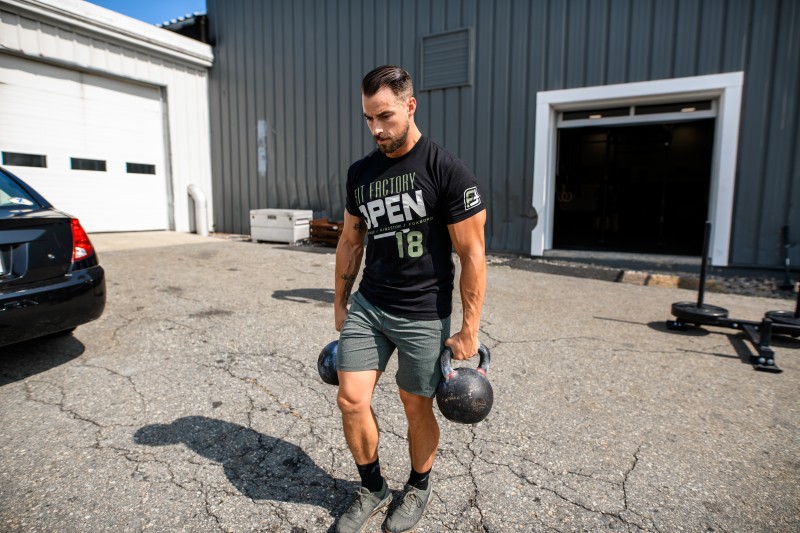
You've heard it before too many times with a tagline like "best training plan," but this article isn't meant to convince you that you should stop what you're doing and start a new program. This training plan certainly isn't for everyone, but for the right person, it's hard to beat. Let me explain.
If you're reading this article, I'm assuming you're familiar with the conjugate method, and if you've read any of my articles, this probably doesn't come as a surprise to you. Let's cut the BS and talk about who this training plan is right for:
- Experience: You've been using the conjugate method for at least a few years and understand the max effort, dynamic effort, repeated effort methods.
- Schedule: You can devote at least four to five hours a week to your training.
- Injury history: You may be someone who's been in the trenches for a while and you probably have some nagging injuries — that's OK, as this plan will help with that.
- Goals: This plan is for someone who’s not necessarily trying to compete in any given sport. It’s for someone whose goals are to look and feel better, get stronger, and also improve conditioning and recovery. More on this later.
Furthermore, you probably have a lot in common with me — have kids, job, and trying to still make the most of my fitness — my goals revolve around how I feel and look while still trying hit PRs and improving my strength.
Your time is limited, so your plan needs to be concise. Even with all of your commitments outside of the gym, your workouts are very important to you and are a vital part of your mental health. If all of this sounds like you, read on.
Building the Base of your Fitness via Aerobic Work
For years, aerobic work was labeled as the bad guy that would make you slower and gain adipose tissue. Of course, knowing what we know now about energy systems, we know that we can utilize aerobic work to facilitate recovery, improve your ability to generate ATP for explosive sports, and increase the length of your life.
- Research has shown that life expectancy is directly related to aerobic fitness and may help protect against premature death due to cardiovascular disease.
- The aerobic system is the most metabolically adaptable energy system in that it can produce ATP from multiple energy sources.
- The aerobic system produces more molecules of ATP per molecule of substrate.
- The aerobic system is the most adaptable system when it comes to room for improvement.
Moreover, this training plan is going to include non-negotiable aerobic measures, so we can be assured that adaptations happen for both the cardiovascular system and skeletal muscle take place. Among these adaptations include increasing the functional capacity of the heart, increasing the size of the vascular network, and increasing the number and function of mitochondria.
As a result, you’ll be able to recover more efficiently, and in turn, handle more volume in your max effort and dynamic effort training sessions. I’ll warn you though some of these sessions certainly aren’t exciting and will likely feel easy to you.

Aerobic Methods
As previously mentioned, we are using the conjugate method. The lifting sessions won’t be outside what you could find anywhere on the Internet in a typical conjugate split, but the conditioning may be a little different than what you’ve used before. For these conditioning sessions, you’re going to want to invest in a chest-strap heart rate monitor to eliminate any chance of guesswork.
RELATED: How Strength and Speed Training Can Help Build Your Aerobic Training Capacity
There are two methods we’ll use to do this (along with a third optional method), one of which will feel easy and almost as if you’re not training, but this is by design.
1. Strongman Method: Improves posture, grip, and core endurance. Bouts of 60 seconds to 90 seconds. Expect your heart rate to be between 150 to 160 during sets and come down to 130 during rest intervals. These sessions will last between 30 to 40 minutes. This will be the harder of your sessions, but even so, this work should be sustainable and not leave you dead on the floor between bouts.
2. Cardiac Output Method: Improves eccentric hypertrophy of the left ventricle, which is responsible for pumping oxygenated blood to the extremities. Simply put, it’s increasing the cavity volume of your left ventricle. Your heart rate should be between 130 to 150 beats per minute (not to exceed 150, or this adaptation will not take place) and be done using cyclical measures (i.e., light biking, rowing, jogging, light sled pulling, etc.). Sessions should be a minimum of 30 minutes and a maximum of 90 minutes (if you’re like me, 30 to 40 minutes will be the point where you’re ready to call it a day). You can mix and match a variety of modalities that I’ve mentioned to keep it interesting. This session will culminate with five minutes of easy global foam rolling to drive the parasympathetic nervous system (rest and recovery).
3. Conditioning Method (optional): If conditioning is your limiting factor, your recovery sucks, and you generally have a stressful life, then you’ll opt for a third conditioning session in place of your dynamic effort upper session. This will consist of either another cardiac output session OR a recovery session of 20 to 30 minutes of light cyclical work (can use the same measure as cardiac output, but this time your heart rate should NOT exceed 130). This session will culminate with some easy static stretching to drive the parasympathetic nervous system.
Now that we understand the role our conditioning session will play in our training plan, let’s talk about putting all of the pieces together. This template will give you options. You’ll be required to do some thinking on your end, based on what works best for you individually, the facility you train in, and what you have access to in terms of equipment. A sample week has been provided to hopefully give you some ideas and get you started.
The Template
Day 1: Max Effort Lower Session
- Choose 1 core movement (i.e., squat or pull) and work up to a 1RM in using 5-4-3-2-1 rep scheme. Then perform 3-4 singles, building to a 1RM. Take full recovery of 2-3 minutes between heavy sets.
- Special Exercise A: Choose 1 movement geared at building a primary mover from #1 (i.e., hip-, hamstring-, quad-, or gluteal-driven movement). Perform 4-5 sets of 6-8 reps with moderate to heavy loading. Rest 90-120 seconds between sets.
- Special Exercise B: Unilateral Variation: 3-4 x 10-12 each. Rest 60 seconds.
- Special Exercise C: Upper Back Complex Variation: 1 variation of 3-4 x 12-15. Rest 60 seconds between sets.
- Banded Tendon Work: Accumulate 100-150 reps of banded leg curls or banded pull-throughs or banded glute hip thrust.
Day 2: Strongman Endurance
Perform 30-40 minutes of loaded carries (i.e., sled pushes or pulls, stone or heavy sandbag carries, SS Yoke Bar Walks, etc.).
Day 3: Max Effort Upper Session
- Choose 1 core movement (i.e., bench press or pull-up variation) and work up to a 1RM performing 5-4-3-2-1. Then perform 3-4 singles, building to a 1RM. Take full recovery of 2-3 minutes between heavy sets.
- Special Exercise A: Choose 1 movement geared at building a primary mover from #1 (i.e., triceps, upper back, or shoulder). Perform 4-5 sets of 6-10 reps with moderate to heavy loading. Rest 90-120 seconds between sets.
- Special Exercise B: Vertical Pull Variation: Perform a total of 20-30 reps of weighted vertical pull-up variation.
- Superset: Single joint movements of antagonist muscle groups (i.e., back/triceps, biceps/triceps, shoulder/biceps). Perform 4 sets of 10-12 reps per movement resting 60 seconds between each movement.
- Banded Tendon Work: Accumulate 100-200 reps banded pushdowns.
Day 4: Cardiac Output Method
Perform 30-90 minutes of low-intensity work (i.e., walking on incline on treadmill, biking, Stairmaster, light jogging, rowing, light sled-pulling, etc.). Heart rate should NOT exceed 150 BPM and average around 135.
Day 5: Dynamic Effort Lower
- Perform a squat variation for 8 x 3 @60% of 1RM or a load that allows you to move efficiently/as fast as possible with short bouts of rest. Perform a set every 60 seconds. If you can use accommodating resistance, drop the load to 50%.*
- Jump Variation: Perform a different variation every other week (i.e., seated dynamic box jumps, kneeling jumps, resistance box jumps, etc.). Perform 8 x 3-5 every 60 seconds.
- Special Exercise A: Pick an area of weakness in the lower body and perform 100 total reps.
- Special Exercise B: Pick an area of weakness different than #3 and perform 100 total reps.
*Perform different variations for your special exercise work than you performed on Day 1.
Day 6: Dynamic Effort Upper
- Perform a bench press variation for 9-12 sets of 3 reps every 45 seconds with 40-50% of your 1RM or a load that allows you to move as fast as possible on each set. Use 3 different grips through your 9-12 sets.*
- Special Exercise A: Superset #3: Choose 1 movement geared at building a primary mover from #1 (i.e., triceps or upper back). Perform 4 sets of 15-20 reps with moderate to heavy loading. No rest between sets.
- Special Exercise B: Choose 1 movement for the upper back and perform 4 sets of 15-20. Rest 60 seconds between repeating supersets.
- Special Exercise C: Direct Biceps Work: 3 x 8-10. Rest 60 seconds.
*Perform different variations for your special exercise work than you performed on Day 3.
Day 6 Conditioning Option: Active Recovery
Perform 20-30 minutes of light cyclical work (can use the same measure as cardiac output, but this time your heart rate should NOT exceed 130). This session will culminate with some easy static stretching to drive the parasympathetic nervous system.
Additional Considerations
- Rotate max effort variations weekly and retest every 12 weeks.
- Rotate special exercises weekly or biweekly. This will depend on you in terms of how much novelty you require in your plan. I personally rotate my special exercises weekly.
- Perform dynamic effort exercises for 3 weeks, then rotate your variations.
- Percentages increase only by 5% each week for lower-body and upper-body.
- Don’t neglect active recovery days. Aerobic work is imperative for facilitating recovery so don’t worry about losing your gains with some light jogging or walking.
- If possible, track your HRV to determine your training ability.
Sample Week
Day 1: Max Effort Lower Session
- Sumo Rack Deadlift with Chains: 5-4-3-2-1, then 3-4 x 1 to max. Rest 3 minutes.
- Glute Ham Raises: 5 x 6-8. Rest 90 seconds.
- SS Yoke Bar Front Rack Reverse Lunges: 4 x 6-8 each. Rest 60 seconds.
- T-Bar Rows: 4 x 10. Rest 60 seconds. Alternate grips for each set.
- Single Leg Banded Hamstrings Leg Curls: 2 x 50 each. No rest.
Day 2: Strongman Endurance
EMOM 40:
- Minute 1: Moderate Weight Sled Push for 100 feet
- Minute 2: Front Rack Kettlebell Carry for 100 feet
- Minute 3: Heavy Stone or Sandbag Carry against stomach for 100 feet
- Minute 4: Backward Sled Drag for 100 feet
- Minute 5: Recover for 60 seconds
Day 3: Max Effort Upper Session
- Pin Bench Press with Chains: 5-4-3-2-1, 3-4 x 1, building to a max for the day. Rest 120 seconds.
- SS Yoke Bar JM Presses: 5 x 8. Rest 60 seconds.
- Neutral Grip Chest to Bar Pull-ups: 4 x 6-10. Rest 90 seconds.
- Dumbbell Lateral Raises: 3 x 15. Rest 60 seconds.
- Banded Triceps Pushdowns: 3 x 50. Rest 60 seconds.
Day 4: Cardiac Output Method
Perform 30-40 minutes of low-intensity work (i.e., walking on incline on treadmill, biking, Stairmaster, light jogging, rowing, light sled-pulling, etc.). Heart rate should NOT exceed 150 BPM and average around 135.
Day 5: Dynamic Effort Lower
- Moderate Stance SS Yoke Bar Box Squat with Parallel Box: 8 x 3 @60% of back squat every 60 seconds; or 50% of back squat + 25% of max with band tension or chains.
- Seated Dynamic Box Jumps: 8 x 5 every 60 seconds.
- Reverse Hypers: 4 x 25 @50% of back squat. Rest 60-90 seconds.
- Goblet Squats: 40-30-20-10 as fast as possible with a heavy kettlebell or dumbbell.
Day 6: Dynamic Effort Upper
- Speed Football Bar Bench Press: 10 x 3 @50% of bench press every 45 seconds; or 40% of bench press + 25% of max with band tension or chains.
- Superset with #3: Dumbbell Incline Bench Press: 4 x 12-15. No rest.
- V-Handle Lat Pulldowns: 4 x 12-15. Rest 60 seconds.
- Banded Overhead Triceps Superset with Cable Facepulls: 4 x 25. No rest between sets.
Day 6: Conditioning Option (Active Recovery)
Perform 20-30 minutes of light cyclical work (can use the same measure as cardiac output, but this time your heart rate should NOT exceed 130). This session will culminate with some easy static stretching to drive the parasympathetic nervous system.
In Summary
If conditioning/recovery is your limiting factor, it may be time to take control and start prioritizing your conditioning. Personally, the aerobic piece was always the missing element for me, as it’s easy to skip this work. But when you do start making this work a priority, other great things in your lifting sessions start to happen. Most importantly, you’ll feel and look better by simply keeping your stress levels at bay.
Images courtesy of RX Photography











Great to see, we made the big time.
What do you think about making day 1 and 3 full body workouts? Do you think that would be a smart idea?
I wouldn't recommend that. If you're looking for a full-body workout plan to fit your schedule this wouldn't be the right fit for that.
Jason
Do you have any 4-day strength training full body routines you have put out anywhere else?
Also, with this, do you keep the strongman stuff fairly heavy? What kind of RPE should we be working at.
Thanks for the feedback!
We rotate ME variations weekly and DE work done in 3-week waves.
Mike - absolutely. The only thing I'd change would be using variations that work best for your individual limitations.
First of thank you for a great guide, I'm programing it as my strongman routine right now.
I just need clarification for the "5-4-3-2-1 warm up routine", is it just generally "ad 10%" each go and hit prescribed reps or is it more to it? And could you please give an example for a "upper back complex", I have never ever deal with "complexes" and did not find anything useful when searching in regards to upper back training.
Thank you
If my 1 rep max is 100 (for simplicity), what would all the sets be (weight x reps) so I understand.